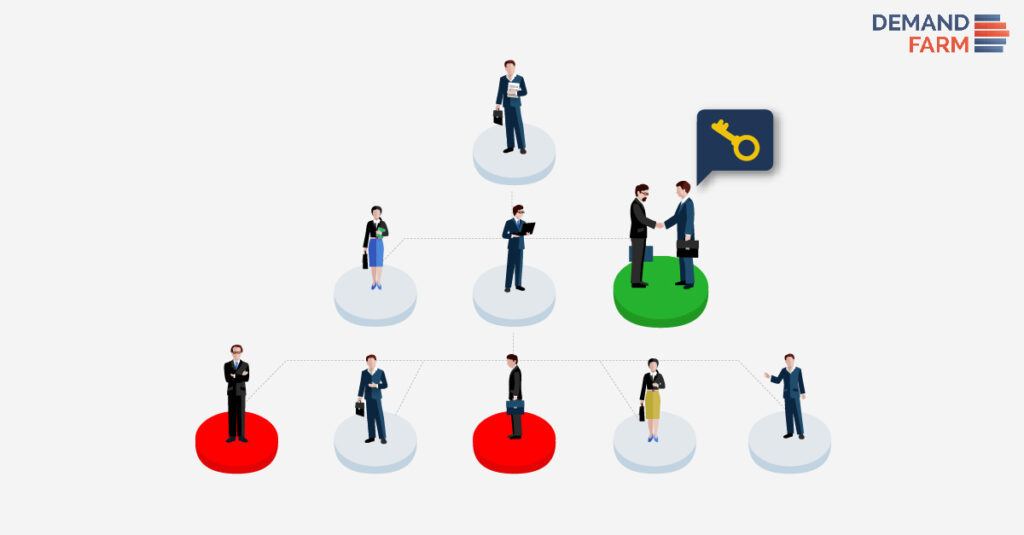How to Ensure Your Key Accounts are in Good Health – Top View

It is all very well to think and expect that your C-Suite in your Key Account Management structure will live up to your expectations vis-à-vis Key Account Health and they will know every little bit of detail that needs to be known. However, if you are using traditional health monitoring methods, then this is next to impossible. After all, when your Key Accounts scale up, how much is one Director or a handful of your top people going to know about the details?It is, therefore, necessary to have a transparent system that addresses the 3 points listed below: Is your KAM team cued into the key goals and success parameters of their clients? Sharing the above in black and white with the team assigned for KAM Sales is very important to measure the performance of the Key Accounts. This adds to the building of trust and retaining of the Key Account as the client sees your team as his trusted advisors, who are working with him towards a common goal. Unfortunately, though, this is not the case. Many Key Account Managers are not aware of the tangible goals or have not got it in writing. Are the contracts well documented and broken down in small, understandable, easily accessible dockets? The answer to this is usually, NO. Contracts are big 30 pager documents which are lost in the grind and dug up only before the all-important reviews or during a crisis. The Strategic Account Management team often forgets or is not aware of the small details on say Page 24 that a client may refer to when he is not happy. At that time, it is too late. As the top management, it is important that you have your entire team completely cued into each and every detail of the contract, however, big the contract. The best way to do this is to document the contract into small-sized dockets accessible to all for regular browsing. These need to be discussed and rehearsed during every weekly meeting for quick recall from the team. This practice ensures that the goals listed down and well discussed are also well followed and achieved. Has your team put down in writing clear internal goals that increase the probability of retaining that key account? Internal goals have to be quantified to measure what the team is up against. The account health as defined above depends on the frustrations in the account management that crop up. It helps you, as a Director, to quantify these frustrations and discuss this with the team clearly, so that you can all put your heads together to improve the situation. Generic, non-tangible goals and performance measures are not enough; they should have a strong metric system in place that can be easy, transparently monitored from anywhere. Team members need to have access to this system. Clear, measurable insights into Key Accounts are known to increase not just customer retention, but also positively impact profitability by 25 to 125% DemandFarm’s Key Account Management software helps you and your Key Account Management team to quantify these goals, spot the gaps and improve them for better performance in the relationship mapping and profitability of Key Accounts. Also read our blog on Key Account Management VS Regular Account Management.
The Key Account Management Secret No One Tells You About

Key Account Management is necessary for the organization’s growth. Let me share its secrets. An Old Friend Brings Up An Old Challenge A few months ago an old friend from business school reconnected with me and wanted to meet up for a chat. During the evening, I was happy to learn that he is doing well in his career – so well that he is looking after close to half of his company’s major clients – quite a feat. Once all the congratulating was over, though, I could hold back no longer and had to ask, “so, how do you ever sleep at night”? With all the complexity that each Client entails, managing one is tough enough. And here, my friend had several Key Accounts, albeit with an extremely competent team of Key Account Managers to work with him. But the fact remains it could not be a cakewalk. ‘Yep. It has been more than tough. For a while there I had given up sleeping at night! And in all those waking hours, I have been giving it much thought. So this is why I am here today. Sometimes you need to undo what works to get the formula to get better and sometimes you just got to maybe go back to the basics”.Me (antennae on high alert for some juicy insight about Strategic Account Management ) “Tell me all about it!” Casing The Conundrum “You know the drill with Key Accounts. Each Account Manager is the king of his castle. As long as it ain’t broke, you do not try and interfere as their Manager..you just look at the numbers and keep your thumb up. PEOPLE…(he paused meaningfully).. is the key to Key Account Success. It is all about relationships mapping – their relationships with clients and internal stakeholders – and Intel – in their head and their laptops, emails, wherever – you know the drill. Of late, my level of dependency on these people had been bothering me. You know, in spite of our best efforts to create a desirable work culture and environment, I have no guarantees on how long any of them will stay with us. If even one of them leaves, it would take me months to rebuild what may be lost – if at all I can rebuild it to the same level. This was what kept me up at night.There has to be a way to take Account Management from person dependent to process driven..but that would mean taking away the very essence of Key Account Management – which is that each Key Account Relationship is owned, grown and nurtured by a dedicated Manager who had the freedom and flexibility to meet all his Key Clients’ needs in the most customized, individualized way! Quite a conundrum!And what’s more, (he was really on a roll now, my friend!) my Key Account Managers are all highly experienced professionals…they have been doing what they do for a long time..and they are darn good at it…but it is difficult to get them to work in ways other than what they are used to…they see it as a disruption to their work and often it’s quite a challenge to get them to participate in anything like that. Recently we spent a bomb on a sales excellence methodology training and everyone said they really enjoyed it – but guess what..once they went back to daily life, it was business as usual – my Ops guys sifting through a million different files and presentations to make sense of what was going on with each Account, trying to stitch together the big picture for me, you know…how could we operationalize all that we developed in the methodology training in a coherent way across the board? You know, given that whole conundrum we just spoke of…how can we possibly……institutionalise the core KAM processes?” I finished for him.“Exactly. How can we? (pause) Should we?” That was then That conversation left us both with a lot more questions than answers but in the time since then; I took this challenge back to our team at DemandFarm. Anything that keeps KAM professionals up at night keeps us up at night, so we spent a lot of time working on the basic question – can- and should- we attempt to operationalize the core Key Account Management model to improve efficiencies, effectiveness, and governance in large B2B organizations? And if we did find a way to do that in our Key Account Management Software, would it be adopted by KAMs? Would it take away from their ability to customize and improvise the way they managed and grew their Key Accounts?We have spent several months tearing into this question and its implications. We have looked at it from many angles, many perspectives. The pros and cons of doing such a thing. And slowly, we did see the light at the end of the tunnel. It was time to set up a meeting with my old friend.
The Best Org Chart Software doesn’t help KAM

If you are wondering what is the connection between what an org chart software does and key account management, I encourage you to read one of our previous blogs. The connection isn’t apparent. But, organizational charting is critical to key account management success. The org chart software market is crowded, fragmented, and under-penetrated. Not all organizations need sophisticated software to draw organizational charts. Excel, PPT, and good old paper still do the work, pretty much. I am sure you don’t want me to write about the reckless org chart printouts that users take. Let us dig a little deeper. A search for “Best Org Chart Software” throws up many options. At one end you have enterprise versions like LucidChart, software to support Visio to many products for small businesses that are also free. Can these aid key account management and its associated complexities? I am afraid, “No”. The following are the reasons why the best org chart software in the market does not help Key Account Management at all. Purpose of the Best Org Chart Software Org Chart Software is not designed for Key Account Management. The software’s purpose is very different. Let me illustrate this with an example. Turn to any of the software listing websites like Capterra, Software Advice, G2Crowd. Did you notice that Org Chart Software is usually a sub-category under Human Resources Software? What does that tell you? The org chart software available in the market caters to HR requirements. The software features, at best, address the operational problems in building business-friendly usable organizational charts. Key Account Management Insights Org Chart Software for Better Key Account Management explained the role of a specific type of org chart that would be a valuable aid for key account managers. Key account managers require an account facing an external organizational chart. Such an org chart builder must highlight the possibility of value creation for the KAM’s account. The existing software in the market cannot serve this purpose and innovations in KAM technology over the years have experienced a dormant growth rate. Because they are inherently passive and do not capture the changing situations under which KAMs operate. An Organizational Chart for key account management has very specific requirements that are often nuanced. Salesforce Integration Businesses with established key account management practices also happen to be Salesforce power users. The best organizational chart software for key account management should sit on top of existing CRM systems like Salesforce. This would give it the necessary prowess to render org charts dynamically, as demanded by business. DemandFarm offers Salesforce Organization chart and MS Dynamics Org chart software in the market integrates well only with ERP systems and other HR software. Key Account Management needs its own Org Chart DemandFarm’s blog has always made a case for a continuous strategic approach to key account management. Understanding the role of stakeholders that comprise an account is a valuable piece of information. As stakeholders increase within an account, insights tend to decay. This adds ambiguity to decision-making. At times, it could also mean compromising revenue goals. Thus, impacting even the business plan. A good organizational chart for key account management is just good business. Isn’t it?


